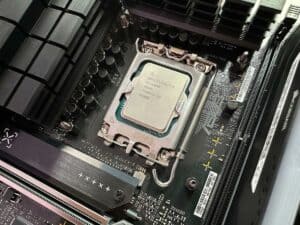AMD EPYC Bergamo brings up to 128 Zen 4C cores
A seriously large amount of cores optimized for the cloud

WePC is reader-supported. When you buy through links on our site, we may earn an affiliate commission. Prices subject to change. Learn more
AMD’s EPYC Bergamo CPUs were announced at the recent AMD Data Center & AI Technology Premiere. These impressive CPUs offer the best performance for optimized cloud computing. We show how AMD EPYC Bergamo brings up to a massive 128 Zen 4C cores.
What is the EPYC Bergamo chip?
AMD’s EPYC Bergame is designed specifically for native cloud computing.
The EPYC Bergamo flagship will feature 128 cores, 256 threads, featuring 82 Billion transistors, and feature a 35% smaller Core Die area. Here is a full list of the specifications we know so far:
- Up To 128 Zen 4C Cores
- 256 Threads
- TSMC 5nm process
- Consistent x86 ISA
- 82 Billion Transistors
- Greatest vCPU Density
- Best Energy Efficiency AMD has ever offered
- 35% Smaller Core Die Area With the Same Process
- Up To 2.6x Faster Than Sapphire Rapids In Cloud-Native Workloads.
If Bergamo interests you, you should check out Genoa-X’s performance.
What do we know about the Bergamo CPU?
The AMD EPYC Bergamo CPUs are highly anticipated due to several key features. Based on the available information, it is known that the Bergamo CPUs will have up to 128 cores, utilizing the Zen 4C architecture. These cores are fabricated using TSMC’s 5nm process node, which represents a slight improvement over the 5nm process used for Zen 4 cores.
In addition, the Bergamo CPUs will support up to 256 threads, enabling efficient multi-threading. This is in contrast to Intel’s E-Cores, which do not offer the same level of multi-threading capability. The Bergamo CPUs will also support 12-channel DDR5 memory and PCIe Gen 5.0 functionality.
One notable advantage of the Bergamo CPUs is their drop-in compatibility with the existing SP5 socket. This means that no software porting will be required, as the same Zen 4 Instruction Set Architecture (ISA) is used.
The Bergamo chips consist of eight Zen 4C Core Complex Dies (CCDs), each containing up to 16 Zen 4C cores. These CCDs are organized into two Compute Complexes (CCXs), with each CCX featuring 8 cores. Additionally, each CCX has a shared 16 MB L3 cache. This represents a return to the dual-CCX structure for Zen 4C, departing from the singular unified CCD/CCX configuration seen since Zen 3.
AMD has managed to fit twice the number of cores and threads within a slightly larger die size compared to Zen 4. The Zen 4C CCD, also known as “Dinoysus,” has a smaller core area and reduced aspects by around 35% to 45%. The Bergamo chips contain a total of 82 billion transistors.
Even when comparing individual core sizes, the Zen 4C core is smaller than the Zen 4 core, measuring 2.48mm2 and 3.84mm2, respectively. Both cores are fabricated using the same TSMC 5nm process node.
What is Zen 4c?
Zen 4C refers to a specific iteration of Zen cores developed by AMD for their EPYC Bergamo CPUs. Zen 4C cores are designed to be density-optimized, meaning they prioritize maximizing the number of cores on a die. Compared to the traditional Zen 4 die, Zen 4C cores offer double the core count.
For example, while Genoa offered up to 96 cores, Bergamo is expected to provide up to 128 cores with half the die area. Zen 4C cores are specifically designed for servers where a higher number of cores is required.
If you missed the AMD data center and AI technology premiere, you can watch it on Youtube. This was how AMD EPYC Bergamo brings up to 128 Zen 4C cores.





